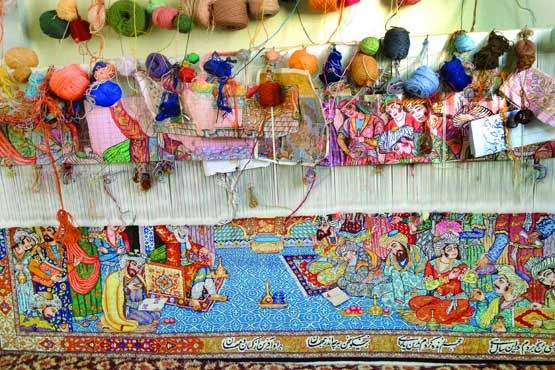Unveiling the Beauty of Oriental Hand-Knotted Carpets and Handmade Rugs
The Timeless Elegance of Persian Carpets
Oriental hand-knotted carpets and handmade rugs hold a special place in the world of interior design and craftsmanship. These masterpieces, created by skilled artisans over weeks or even months, are more than just floor coverings—they are pieces of art with history, culture, and tradition woven into every thread.
At Rugs Land, we aim to guide you through the fascinating journey of these timeless creations, helping you appreciate their beauty, craftsmanship, and cultural significance.
The Craftsmanship Behind Hand-Knotted Carpets
What sets Oriental hand-knotted carpets apart is the meticulous artistry involved in their creation. Every carpet is crafted knot by knot, using techniques passed down through generations. The process is intricate and labour-intensive, often taking several months to complete a single piece.
Key features of hand-knotted carpets include:
- Durability: Their tightly woven structure ensures exceptional longevity.
- Unique Designs: No two handmade rugs are identical, giving each piece a distinct character.
- Natural Materials: Traditional rugs use high-quality wool, silk, or cotton, which contribute to their vibrant colours and luxurious textures.
- Cultural Significance: Each pattern and motif tells a story, often reflecting the heritage and traditions of the region where it was made.
Types of Oriental Handmade Rugs
The world of Oriental carpets is vast and diverse, encompassing a variety of styles and techniques. Here are some notable types:
- Persian Rugs: Renowned for their intricate designs, Persian rugs often feature floral motifs, medallions, and rich colour palettes.
- Afghan Rugs: Known for their bold geometric patterns, Afghan rugs embody rustic charm and simplicity.
- Turkish Rugs: Using double-knot techniques, Turkish rugs are famous for their durability and vivid patterns.
- Indian Rugs: Inspired by Persian styles, Indian rugs blend tradition with contemporary aesthetics.
Each type of rug reflects the artistic traditions of its origin, offering a unique window into its cultural history.
The Timeless Appeal of Handmade Rugs
Oriental carpets are more than just functional items—they are investments in beauty, history, and quality. Here’s why they remain timeless:
- Versatility: Handmade rugs can elevate any space, whether it’s a modern apartment or a classic home.
- Sustainability: Crafted using eco-friendly methods, these rugs are an excellent choice for those who value sustainable living.
- Aesthetic Impact: With their rich textures and intricate designs, Oriental rugs add warmth and personality to any room.
- Collectible Value: Many hand-knotted carpets appreciate in value over time, making them sought-after collectibles.
Tips for Caring for Your Handmade Rugs
Owning a hand-knotted rug is a privilege, and proper care can ensure its beauty lasts for generations:
- Regular Cleaning: Vacuum your rug gently to remove dust and prevent dirt buildup.
- Protect from Sunlight: Prolonged exposure can fade colours, so position your rug away from direct sunlight.
- Rotate Periodically: This prevents uneven wear and maintains its structure.
- Professional Maintenance: Every few years, have your rug cleaned and restored by experts.
By following these tips, your Oriental carpet will remain a cherished part of your home for decades.
The Cultural Significance of Oriental Rugs
Oriental rugs are more than decorative pieces; they are cultural artefacts. For centuries, these rugs have been symbols of hospitality, wealth, and artistic expression. They often reflect the social, religious, and historical context of their creators.
For example:
- Persian rugs often feature motifs of gardens and nature, representing paradise and tranquillity.
- Afghan rugs incorporate tribal symbols, narrating stories of their communities.
- Turkish kilims are known for their symbolic patterns, which often carry wishes for prosperity and protection.
Understanding these elements allows you to appreciate these rugs beyond their aesthetic value.
How to Identify a Genuine Oriental Carpet
With so many options in the market, distinguishing a genuine Oriental rug from a replica can be challenging. Here are some tips:
- Check the Backing: Genuine hand-knotted rugs show the design on the back, unlike machine-made ones.
- Feel the Texture: Handmade rugs often feel softer and more luxurious.
- Inspect the Knots: High knot density often indicates better quality and more intricate designs.
- Ask for Certification: Authentic Oriental rugs often come with certificates of origin.
By paying attention to these details, you can ensure you’re investing in a true masterpiece.
Exploring the World of Oriental Rugs with RugsLand
At RugsLand, our mission is to educate and inspire rug enthusiasts by exploring the artistry, history, and cultural importance of Oriental hand-knotted carpets and handmade rugs. Whether you’re a collector, a home decorator, or simply someone who appreciates beautiful craftsmanship, our blog provides a wealth of information to enhance your understanding and appreciation of these timeless treasures.
Stay tuned for our in-depth articles, care tips, and fascinating insights into the world of handmade rugs.
What is Special About Persian Rugs?

